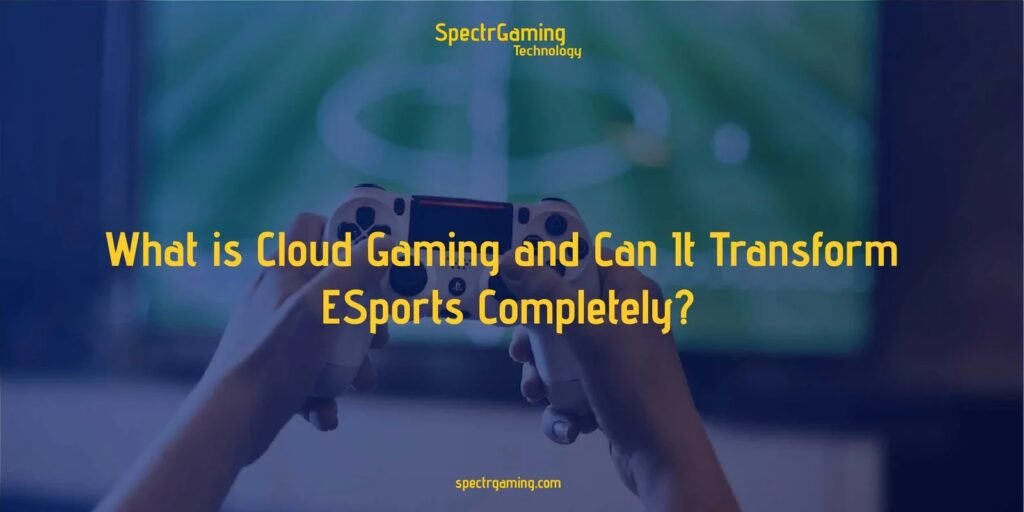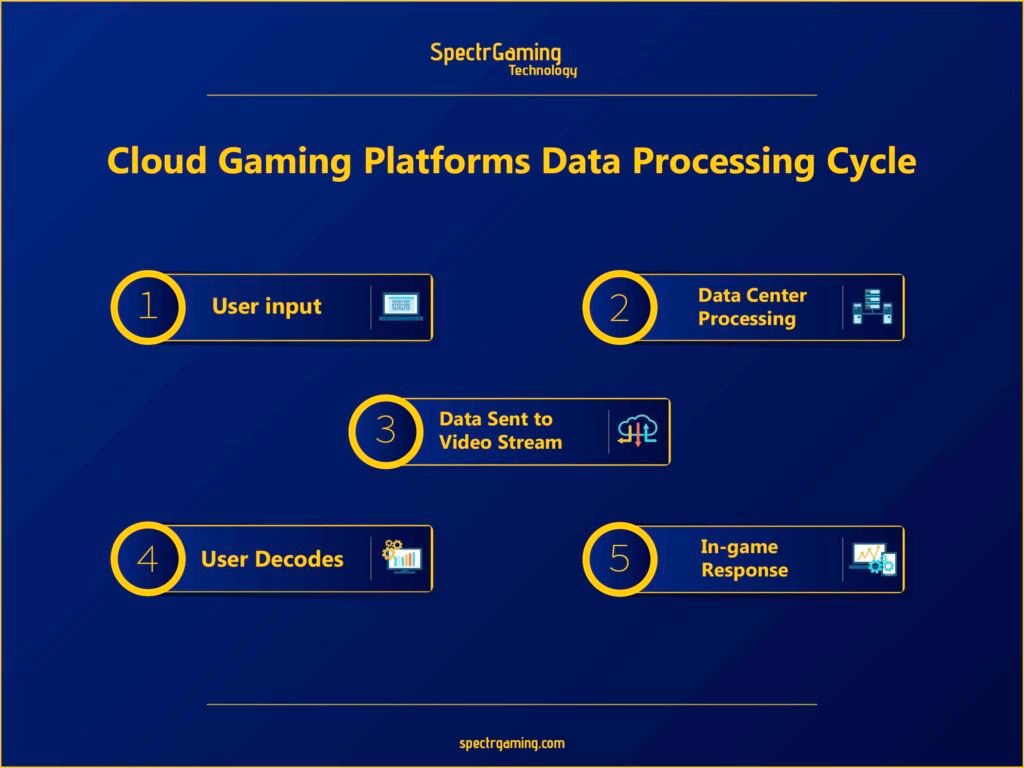
Cloud gaming is the next generation of electronic entertainment or esports. It is the concept that is taking gaming beyond the limitations of hardware and software. Yes, you read that right!
With cloud gaming players can enjoy their favorite games anywhere, anytime, right on their very own devices, regardless of any requirement and system constraints. This can push gaming off the limits and the esports market can become even more competitive.
Many big names in tech are investing in this technology as the statistics show a significant growth rate in the cloud gaming market which is expected to reach $18.7 billion by 2027.
This blog will cover everything about cloud gaming and will answer most of your questions on future trends and expectations.
What is Cloud Gaming?
Before diving deep, let’s get a brief overview of the concept of Cloud gaming. Ever heard of a Video-On-Demand (VOD) service? It allows users to access any video, TV show, or movie from anywhere, anytime. YouTube is a prime example of it.
Cloud gaming operates in a very similar manner to this, by storing and executing games remotely without any local interaction. In this process, you don’t have to download and install games on your PC or console, instead, you can play your favorite games via client software.
You only get the game interface on your end, other than that all the interactions, keypresses, or more generally the input from your end is sent back to the server. The back-end processes all inputs and executes the action in-game that appears back to the client side and you see your players acting on your commands.
Internet connectivity and bandwidth impact gaming on the cloud heavily as the remote server renders and plays the game, while you see and interact with everything locally on your device.
History and Background
Diving deeper, we can find the roots of this revolutionary cloud gaming concept from a Finnish startup G-cluster announced in 2000 (officially released in 2003). Later G-cluster partnered with a major server manufacturer to deliver their games to both network operators and end-users, transforming their business model.
Other names like Infinium Labs (now known as Phantom Entertainment) intended to transform the gaming industry with their console having cloud gaming capabilities in early 2003. It was able to deliver on-demand video games with a monthly subscription fee.
Crytek, the developer behind the Crysis franchise also began their research on taking the popular sci-fi shooter to the cloud but the development was later halted due to high infrastructure and internet costs.
How Does Cloud Gaming Work?
There are many queries regarding cloud gaming. Is cloud gaming good? Will it replace traditional gaming techniques? To get the answer to these questions let us first understand the tech behind cloud gaming.
Infrastructure Setup
Starting with the infrastructure and technology, cloud gaming requires providers to ensure the availability of:
- Data Centers
- Server Farms
- High Bandwidth-Internet
- Connection with the Lowest Latency Possible
5-Step Cloud Gaming Data Cycle

- User input is sent to remote data centers via the Internet.
- Data centers process and render the game in almost real-time on powerful servers.
- The game’s video stream is encoded and sent back to the user’s device.
- The user’s device decodes and displays the game graphics while sending ongoing input commands.
- Real-time gaming interaction happens as the user plays, and audio is also streamed to their device.
Real-life Use Cases – Success and Failure Side by Side
Cloud gaming is still not as popular as someone would suggest, but it is a reality! Big tech players have invested millions of dollars in setting up gaming servers. Speaking of corporations, the two most prominent names in the gaming on the cloud are Google, Microsoft, and Nvidia.
Google Stadia
Google Stadia was Google’s cloud streaming and gaming platform, but it is no longer available as the tech giant shut down all Stadia operations in February 2021. This short-lived platform followed a model that allowed users to purchase and run games in high-definition on any compatible device without any waiting times. On subscription to a better package, the games were automatically upscaled to 4K.
At the launch of this platform, people were calling Stadia, “Netflix for games”, but the platform wasn’t able to survive in the market for a long time. According to the tech giant, Stadia did not receive the traction from the audience they were hoping for.
GeForce Now
GeForce Now is the cloud gaming platform that was made public by the well-known GPU manufacturer, Nvidia, in 2020. This platform works on a different model than Google Stadia. GeForce Now allows you to purchase games from other game stores like Steam, but it makes you wait to stream these games on the Nvidia servers.
Upgrading the subscription allows you to have more playtime and reduces the waiting time to stream your favorite games in real time. The upside of GeForce Now is that it allows you to download and play games locally, ensuring a dedicated experience if you acquire the necessary hardware or lease a graphics card for future play.
Which Cloud Gaming Service Should I Go For?
There are many virtual gaming or services currently but each has its own pros and cons for different sets of players. Let’s break down the type of service you should opt for depending on these preferences:
PC Gamers
Players who game on PC have to go with GeForce Now, without even searching for any other cloud gaming and streaming service. It’s compatible with the PC games you already have, and you can still play them later on if you decide to go for a local setup. Shadow is a solid second option if you’re looking for a powerhouse PC in the cloud.
Console Gamers
For console players, there are two prominent solutions in the industry. You have to pick your side with either Xbox Cloud Gaming or PlayStation Now. PlayStation Now is like a direct game streaming service for those consoles and Windows 10 PCs – no need to own a PlayStation at all. On the flip side, Microsoft’s is a two-in-one deal: you can either stream your installed games or dive into a selection of titles from the Game Pass library.
Is Cloud Gaming the Future?
Cloud gaming has its pros and cons, as many gamers are not very comfortable with cloud setups, especially for competitive gaming. Most average gamers who enjoy online titles such as Valorant, CS2, Fortnite, and others rely heavily on the internet connection. A little ping drop can cause a complete mess in these titles.
Speaking of fast and reliable internet, Google Stadia (closed) required at least 35 mbps internet for 60 fps gaming at 4K resolution without any stutters. Having this internet is not a big deal if you are Shroud or Ninja, but for an average gamer looking to enjoy gaming on weekends, it’s quite an issue.
Let’s set this issue aside for a while as only competitive players need to deal with it, so what about single-player titles that need the latest GPUs? Is it the best option to play them? Let’s dive deeper into the three key factors this revolutionary technology can address.
Resource Management
The biggest upside of cloud gaming is resource management in terms of hardware. From game installation to performance optimization, it comes on top, as you don’t need to worry about anything other than staying connected. For instance, the latest Call of Duty: MW3 requires about 150GB of SSD space. That is quite a lot of storage for a single title for most average gamers. Cloud gaming not only eliminates this concern but also provides you with the best performance and storage options (depending on your subscription) with access to premium RTX servers in the case of GeForce Now. This provides a top-notch gaming experience with crispy resolutions and in-game details.
Predictive Input
Tech giants use predictive input algorithms to reduce game lags and keep the online experience as smooth as possible. Google Stadia used this solution to provide the best gaming experience and the upcoming cloud gaming providers like Microsoft for Xbox cloud gaming will implement it.
Accessibility
Playing your favorite game from anywhere, anytime, and even on any device is a promising aspect of cloud gaming. You don’t have to spend thousands of dollars buying a new graphics card or a new console for gaming, all you need is a subscription. Above all, our favorite titles are under one roof without any hurdles of game stores and account verifications.
It is not false to say that cloud gaming is transforming e-sports and gaming overall. But, many factors are still in the way of seamless cloud gaming integration to the life of an average gamer. The future of cloud gaming is still a miss or a hit, as Google’s failure to keep up the service is a significant setback to this approach. Nevertheless, the concept offers an excellent avenue for gamers who never gather the money to buy their favorite graphic card or console.
Final Thoughts
To conclude, cloud gaming is a concept that needs refinements before it can make headlines in the world of gaming. For now, the gaming industry is moving towards more immersive and seamless experiences with new multiplayer modes and graphic improvements. In terms of virtual gaming, Microsoft is investing large amounts in Xbox cloud gaming servers to make it a go-to solution for most gamers out there. Today, the market is worth $4.34 billion, with more advancements to come by the end of 2023. We will witness more cloud apps, even on smart TVs and streaming services like Netflix. The future of gaming appears poised for continuous evolution and improvement, making it an intriguing space to watch for upcoming developments.
FAQs
1. Valorant, CS, and Other Multiplayer Titles Support Cloud?
Yes! virtual gaming platforms support multiplayer games, letting you play with others online, similar to traditional gaming setups. You can easily connect to Fortnite, But, Valorant and CSGO are not currently available on the Cloud. However, players might be able to run them via cloud virtual desktop services like Shadow.
2. Will Cloud Gaming Replace Consoles?
No! It is not going to replace consoles or dedicated gaming setups. Instead, it is here to offer players more choices and freedom in how they play games on all platforms.
3. Can Cloud Games Be Hacked?
No! Cloud platforms provide enhanced security, minimizing the risk of external disruptions like hacking. The information is stored in a virtual space, reducing exposure compared to traditional client-server setups.
4. Which Cloud Gaming Platform is Free?
Different service providers offer free but limited access to services.
- GeForce Now: Free membership provides basic rig, 1-hour access, and standard access to servers
- Xbox Cloud Gaming: Free for players having an Xbox Game Pass Ultimate subscription
5. Does Cloud Gaming Save Progress?
Yes! Even when you uninstall a game, the cloud server stores the saves. On reinstalling the game later, it syncs the saves back, allowing you to pick up right where you left off.